|  
IN THE NEWS | INTERVIEW | CALENDAR
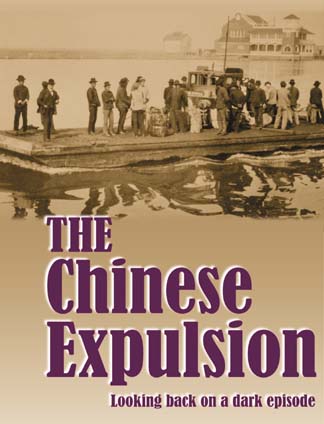
by KEITH EASTHOUSE
It didn't take Jean Pfaelzer [in photo below right] long to notice something odd about the class she was teaching at Humboldt State University: no Asian students. There were significant numbers of Native Americans in the Humboldt student body back then, in the late 1970s. There were also noticeable numbers of other minorities, particularly Hispanics. But, campus-wide, Asians were few and far between. Puzzled, she made inquiries and soon learned that HSU had a bad reputation among Chinese and Japanese students in particular. It wasn't that the university didn't want them. It was that the students didn't want to come here.  The reason for Humboldt's unpopularity, Pfaelzer eventually concluded, had to do with something that took place over a 24-hour period 118 years ago -- the infamous expulsion of Eureka's entire Chinese population, which at the time numbered about 300 men and 20 women. The reason for Humboldt's unpopularity, Pfaelzer eventually concluded, had to do with something that took place over a 24-hour period 118 years ago -- the infamous expulsion of Eureka's entire Chinese population, which at the time numbered about 300 men and 20 women.
That event, which unfolded on Feb. 5 and 6, 1885, was followed by a second, lesser-known banishment of 23 Chinese cannery workers brought in to work on the lower Eel River in 1906. Arriving in mid-September, they were shipped out in early October after loggers objected to their presence. It was not until the 1950s that the Chinese returned to Humboldt Bay, when Ben Chin arrived and got into the restaurant business. Chin's Cafe, next to Pierson's, is still a going concern. Pfaelzer said that while most Asians don't know the details of this history, they do know the general outlines. "There's a very strong sense of history and of stories passed down. This is clearly if unspecifically known." To this day, there are relatively few Asians in Humboldt County. Ray Wang, director of HSU's Department of World Languages and Culture, [in photo, below left] was shocked when he came here seven years ago. One of the first things he did was open the phone book to look at familiar Chinese last names, including his own. "There are 100 million [Wangs] in China and here I found there were none. I couldn't believe it." 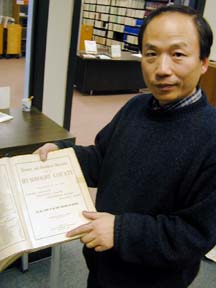 Like Pfaelzer before him, Wang sought an explanation and soon learned about the events of 1885 and 1906. Like Pfaelzer before him, Wang sought an explanation and soon learned about the events of 1885 and 1906.
Many living in Humboldt today know nothing about this dark chapter of local history; those who do tend to view it at a distance, as if it has no connection with the present. But the past treatment of the Chinese lives on today in the form of a population that does not contain nearly as many Asians as it might have. "We would have a Chinatown in Eureka," said Wang, adding that in the 1880s Eureka's Chinatown was not too much smaller than San Francisco's. It's worth noting that no Chinese were killed in the two expulsions. It's also clear that the white population took pride in what it had done. In 1886, the one-year anniversary of the expulsion was celebrated in Eureka; the festivities triggered additional expulsions of the comparatively small Chinese populations of Arcata, Trinidad, Fortuna, Rohnerville and Ferndale. As a result, in the early 1890s, the front page of a local history and business directory was able to proudly declare, in boldface type, that Humboldt was "the only county in the state containing no Chinamen." "I wouldn't go as far as [calling it] genocide," Wang said. "But ethnic cleansing is accurate. People were purged." A public airing On March 11, the matter will get the biggest public airing in memory when a symposium sponsored by KEET-TV 13, HSU and the Humboldt County Historical Society will be held at the university. The featured speaker is Pfaelzer, who's working on a book that promises to be the definitive history. The working title, The Driven Out, is also the title of the meeting. The book's scheduled release date is the summer of 2004. Pfaelzer, 58, taught at Humboldt for only a year -- it was her first teaching gig. But she never forgot what she learned there. "It's a story that's always haunted me. It was always going to be the next book," she said in a telephone interview from her East Coast home last week. A historian of the American labor movement of the late 19th century, Pfaelzer, the author of four works, finally turned her attention to the Chinese expulsion about three years ago. She is currently on leave from the University of Delaware, where she teaches. The university has provided her with a grant to fund the book project. So has the Library of Congress. Random House, which will publish the book, has given her an advance. Pfaelzer even has a writer's lair here in Humboldt for reflection and inspiration, a cottage near Big Lagoon that has long served as a vacation retreat for her and her family. "My heart's in the county. Now that I'm doing a book, it seems I'm out there all the time," she said. She began her research with a single, seemingly simple goal: to tell the tale of the Eureka expulsion. After a few days at the Bancroft Library at the University of California, Berkeley, however, she realized she was onto a bigger story: Chinese expulsions happened not just in Humboldt, but elsewhere in Northern California too, in places like Petaluma, Shasta County and Truckee, where Chinese were killed. The ethnic cleansing, it turned out, was widespread. "It wasn't just a single episode," Pfaelzer said. Pfaelzer estimated that several thousand Chinese were expelled from 40 communities in Northern California in 1885 and 1886. A burst of anti-Chinese activity also occurred outside the state in the same general time period. There was an anti-Chinese riot in the Seattle-Tacoma area and an attempt to purge the population there; a number of communities in Oregon drove out their Chinese residents; and more than 20 Chinese were rounded up and killed in Rock Springs, Wyo., a coal mining area. The tenor of the times While Pfaelzer said she "stays up at night asking myself how this incredible racism spread," she actually had a pretty good explanation: racism was the tenor of the times. While the Civil War abolished slavery, attempts after the conflict to bring political equality to former slaves were quickly defeated. "Afro-Americans couldn't testify, they couldn't vote, they couldn't go to school, they couldn't own land," Pfaelzer said. Jim Crow laws migrated across the county as southern Democrats came west and rose to positions of political power. "They brought a version of the black codes with them," particularly in California, that were applied to the Chinese, Pfalezer said. Some of the laws that were passed were downright petty. In San Francisco, for example, Chinese men were not allowed to arrange their hair in braids or pigtails, a common custom at the time, or to walk around in wooden shoes, which were deemed too noisy. More seriously, the state legislature passed a law requiring Chinese miners to acquire a foreign miner's license, which forced most Chinese workers into other jobs as acquiring such licenses was not easy. On the federal level, the Chinese Exclusion Act of 1882 barred Chinese workers from entering the country and set off a wave of resentment against Chinese immigrants that was fueled by a blatantly anti-Chinese press. While all that was going on, the U.S. government was warring with Native Americans and putting tribal people on reservations after defeating them on the battlefield. What did that have to do with the Chinese? "The idea that you can have an enforced mass migration of people was not unthinkable," Pfaelzer explained. "It was being done. It was available at that time." Against this backdrop was the simple fact that the Chinese were different. "There was an immense lack of understanding of this group of people," Wang said. "They didn't speak English. They didn't go to the same churches. They didn't mingle. They dressed weird. They were deemed as dirty, as a pagan population. They were easy targets." Pfaelzer cited additional factors. An 1875 law that made it illegal to bring Chinese women into the country made it seem that Chinese people were not family-oriented. Because Chinese men were comparatively small and often sported pigtails, they were seen as effeminate -- a perception reflected in political cartoons that depicted Chinese men in homoerotic positions. Finally, unlike many whites, Chinese workers were skilled and efficient, and willing to work for lower wages. It was the belief that the Chinese posed an economic threat that, perhaps more than anything else, explains the hostility that was unleashed against them in the mid-1880s. A tragic shooting It started in Eureka with a random bullet. David Kendall, 56, a member of the City Council for three years, had just finished supper. He was crossing a street in the vicinity of Chinatown, a one-square-block area stretching from E and F streets between Fourth and Fifth streets. It was about 6 p.m. on what Pfaelzer called "a nasty, foggy night." It was Friday, then as now a time of excitement -- and potential trouble. Unbeknownst to Kendall, he was about to step into the history books. Two Chinese men, possibly members of rival "tongs," or gangs, began shooting from opposite sides of the street. Twelve bullets were fired in all. One hit the foot of a 12-year-old boy. Another hit Kendall, killing him. Within 20 minutes an angry mob had formed in the streets of Eureka, chanting "burn Chinatown, burn Chinatown." People poured into a building that no longer exists, Centennial Hall -- "a big old barracks of a town hall" is how Pfaelzer described it -- on the edge of Chinatown. Some 600 shocked and infuriated men jammed into the structure, bent on revenge. The sheriff, Tom Brown, stood up and told the crowd, in Pfaelzer's words, that "I've arrested a bunch of men, but I can't tell you who shot David Kendall." Pfaelzer said there are a couple of ways of reading what happened next. One is simply that "a real lynch mentality" took over as the crowd interpreted Brown's statement to mean that the guilty party or parties would never be found. A different interpretation is that some in the crowd had already concluded that it didn't matter who had killed Kendall; what mattered was getting rid of the real problem -- the entire Chinese population. Under this scenario, Brown may have been pressured to not name suspects. "Maybe it was convenient not to identify" the perpetrators, Pfaelzer speculated. Spontaneous or planned? What is clear is that Brown's statement was pivotal. The crowd "got revved up," as Pfaelzer put it, and without any clear leader it was decided that the Chinese should be removed from the city within 24 hours. A committee of 15 was appointed to enter Chinatown and inform the residents that they had to go. The committee was composed not of wild-eyed fringe elements but of pillars of the community -- men such as future city councilor H.H. Buhne, owner of a large store that supplied hardware and wholesale groceries; Francis Thompson, editor of the Humboldt Standard; Frank McGowan, an attorney; and Dan Murphy, a colleague of Kendall's on the council and owner of the Western Hotel. What really made the expulsion feasible was the presence of two steamships in Humboldt Bay: the Humboldt and the Chester, both of which were used to transport the Chinese to San Francisco. Pfaelzer said that "because of bad weather the ships happened to be in the bay at the same time." Wang raised the possibility that the ships were there specifically to transport the Chinese out of the area. "Obviously, something had been arranged," Wang said. Wang might seem guilty of fuzzy thinking -- after all, how could anyone have foreseen the Kendall killing? On the other hand, the white population was unusually edgy. Pfaelzer said there was violence in Chinatown in the weeks leading up to the expulsion, mainly due to the arrival of some Chinese gamblers from San Francisco. "The Chinatown in Eureka was a very stable, settled part of the community," Pfaelzer said. But with the coming of the gamblers, "suddenly there is violence in Chinatown that hadn't been there before." Did the unrest lead community leaders to plan the expulsion prior to Kendall's murder? That may be going too far, but Wang thinks it's probable that preparations were in the works; all that was needed was an excuse. "Some people with ulterior motives were waiting for a good moment to kick the Chinese out." If Kendall had not been killed, "it would have been something else. People were waiting for a spark to kick up this fire."
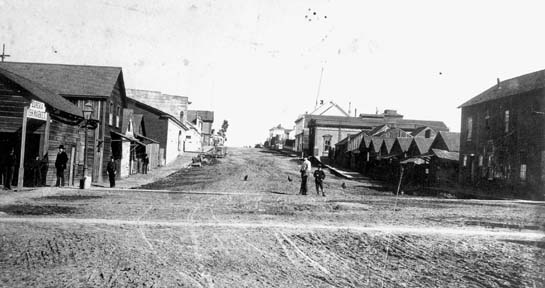
1885 photo of Fourth and E streets in Eureka looking east. Chinatown is on the right and the first few buildings on the left. Eureka City Councilman David Kendall was accidentally shot at this crossing.
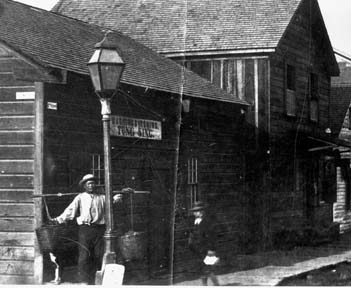
A slice of Eureka's Chinatown in 1885. The sign in the background advertises Washing and Ironing by Tung Sing.
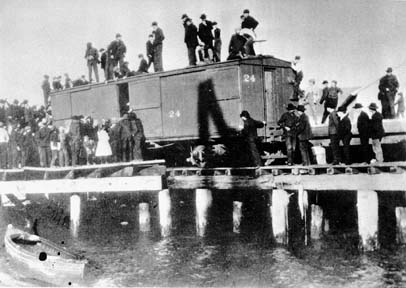
The 1906 expulsion of Chinese people from Humboldt County.
A narrow escape Adding credence to the theory that the expulsion was a less-than-spontaneous event is the fact that what happened in Eureka was much larger and well organized than the other expulsions in Northern California. It was also remarkably free of violence. Nonetheless, the possibility of bloodshed was real. A makeshift gallows was constructed and a sign was attached to the wooden structure warning that any Chinese still in town after 3 p.m. on Saturday would be hung. A Chinese teenager, Charles Lum, made the mistake of stopping in at the house of the Rev. Charles Huntington on his way to the docks; he was being converted and wanted to say good-bye. Outraged that a Chinese had entered a white house, a group of vigilantes burst in, dragged Lum out, lifted him up to the gallows and put a noose around his neck. Fortunately for Lum, Huntington climbed the gallows and talked the crowd out of it. Pfaelzer said she found the plight of the 20 Chinese women particularly poignant. They must have been hobbling as they were herded toward the ships due to the Chinese custom of binding women's feet. They also must have been distraught as many of them were prostitutes who had already been kicked out of places like Sacramento and San Francisco. "In returning to San Francisco, some of them were going into double jeopardy," Pfaelzer said. The banished Chinese arrived in San Francisco the following Monday. A federal marshall tried to get San Francisco police to detain eight to 10 men on the grounds that they were suspects in the Kendall killing, but the police said there wasn't enough evidence. They, along with all the other Chinese on the two ships, were allowed to melt into the city's Chinatown. But the story wasn't over. In a surprising move, 52 former residents of Eureka's Chinatown obtained a white lawyer and sued the city of Eureka, claiming that the city had robbed them of their property. The courts ended up ruling against the Chinese, arguing that they had no standing to sue because they had never been landowners; Eureka couldn't have confiscated what the Chinese had never possessed. Pfaelzer said the ruling "became a flag that no one should sell property to the Chinese." She also said that it was very much like what the courts did to blacks in the Deep South, where former slaves had no legal standing because they owned no land. Other heroes There were other whites in Humboldt besides the Rev. Huntington who stood up for the Chinese. In a well-known incident, Tom Bair confronted a group of Eureka residents when they came to his Redwood Creek Ranch to take his ranch hand, Charlie Moon. Standing in the road with a gun, Bair reportedly told the group that they would have to take him first; the group turned around and left. Less well-known is what happened in Orleans, a mining center in the late 19th century that harbored a large concentration of Chinese. In a 1998 paper published in the Humboldt Historian, the publication of the Humboldt County Historical Society, Orleans resident Philip Sanders and his daughter Laura wrote that only about half of the Chinese population of Humboldt County had been expelled; the other half, many of them miners, was never driven out. Based primarily on the ledgers of two Orleans mercantile stores, the father-daughter team found that in the months following the 1885 expulsion, items that had been popular with the Chinese -- such as rice, canned fish, incense sticks and firecrackers -- continued to be purchased, but by people with European names. Gradually, Chinese names began to reappear in the ledgers, indicating that whites had been protecting them. The owner of one of the stores, William Lord, was particularly sympathetic to the Chinese, even going so far as to harbor them in his home during the expulsion. Lord may not have been entirely altruistic. "The Chinese economic role in town was so considerable that these guys would have been screwed if the Chinese had been forced out," Philip Sanders said in a telephone interview from his Orleans residence. In their article, titled The Quiet Rebellion, Sanders and his daughter estimated the Chinese population of Orleans at 200 individuals or more throughout the 1890s -- a time when officials in Eureka were claiming that the county was free of Chinese. It was a false claim, but as Sanders explained Orleans had once been the seat of Klamath County, which went belly up in 1874. "People didn't see Orleans as part of the county," Sanders said. Incomprehensible hatred As for Pfaelzer, she is clearly in the process of attaining mastery over her material -- both in terms of the Eureka expulsion and the expulsions that were going on elsewhere in that troubled time. But, she said, she will never be able to fully see the situation the way most whites saw it. Even though she thinks it was misguided, she said she can understand the belief that Chinese workers posed an economic threat. What she can't get her mind around is the hatred. "I am by disposition an optimistic and happy person. The part of the story that will never make sense to me as a human being is the contempt for other people."
The KEET connection If all goes as Seth Frankel plans, he and historian Jean Pfaelzer will soon be collaborating on a 30- to 60-minute documentary about the expulsion of Eureka's Chinese population in the late 19th century. Frankel, director of production at KEET-TV, and Pfaelzer have already teamed up to produce four two-and-a-half minute video spots, called "interstitials," on the expulsion that have been airing on KEET of late In part, the purpose of these is simply to drum up interest in a symposium on the expulsion that is taking place at Humboldt State University on March 11. The meeting, scheduled for 7 p.m. in Room 118 in Founders Hall, will feature a talk by Pfaelzer, who is working on a book on the expulsion entitled The Driven Out. But the video spots, funded by $12,500 in grants, are also intended to increase the chances that additional financial support will be forthcoming to fund the larger project. The reason for the sudden attention to Chinese issues is an upcoming three-part series by journalist Bill Moyers on the Chinese experience in America. The series will air on KEET from 9 to 10:30 p.m. March 25-27. That the Frankel/Pfaelzer collaboration happened at all is due to Matina Kilkenny of the Humboldt County Historical Society. Kilkenny, who has known for some time about Pfaelzer's book, put the two in touch after Frankel came to the historical society to do research. Frankel has done documentaries before, notably a 60-minute piece in 2000 on local engineering marvels (such as the Arcata marsh and the dam at Ruth Lake) that got an Emmy nomination; and a historical series on the Rocky Mountains in Colorado, where Frankel worked before coming here. Why, aside from the fact that funding may be available, is a film on the Chinese expulsion worth doing? "The majority of people I've talked to don't even know this happened," Frankel explained. "The point is not to rub peoples' noses in it and say `what a terrible history we have here.' The point is to make people aware so we don't let such things happen again." -- reported by Keith Easthouse
IN THE NEWS | INTERVIEW | CALENDAR Comments? E-mail the Journal 
© Copyright 2003, North Coast Journal, Inc. |